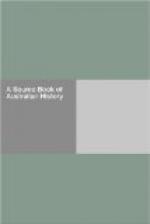Friday, Dec. 17th. They proceed this morning from the beach in a direction about N.N.W. three or four miles in quest of water, when they arrive on the banks of a creek, where they have the good fortune to find abundance of good water and of grass. Here they remain the day, in order to refresh the cattle, who are not a little in want of this timely relief, more particularly as it is proposed to commence their return to-morrow. This determination of so soon retracing their steps, though it cost them much regret, had become indispensable, not only from the extreme scantiness of their remaining supplies, and the certainty of the many difficulties they would have to encounter, but still more so from consideration that the mere circumstance of a fall of rain by swelling the streams, might, in the weak and ill-provided state to which the whole party were reduced, render their return altogether impracticable. (Four weeks’ flour at reduced allowance and a small quantity of tea and sugar, but no animal food; independently of which, the ropes and other material employed for crossing streams were now almost utterly unfit for use.)
THE INTERIOR OF THE CONTINENT.
+Source.+—Expeditions in Australia (Sturt, 1833), Vol. I pp. 1-2, 29, 45, 73, 85-87.
The reedy marshes in which the Lachlan and the Macquarie appeared to end blocked Western exploration until the protracted drought of the twenties convinced Sturt and Hume that they would be passable. Accordingly an expedition was formed which was to solve the long debated problem of the character of the interior.
The year 1826 was remarkable for the commencement of one of those fearful droughts to which we have reason to believe the climate of New South Wales is periodically subject. It continued the two following years with unabated severity. The surface of the earth became so parched up that minor vegetation ceased upon it. Culinary herbs were raised with difficulty, and crops failed even in the most favourable situations. Settlers drove their flocks and herds to distant tracts for pasture and water, neither remaining for them in the located districts. The interior suffered equally with the coast, and men at length began to despond under so alarming a visitation. It almost appeared as if the Australian sky were never again to be traversed by a cloud.
But, however severe for the colony the seasons had proved, or were likely to prove, it was borne in mind at this critical moment that the wet and swampy state of the interior had alone prevented Mr. Oxley from penetrating further into it in 1818.
The immediate fitting out of an expedition was therefore decided upon, for the express purpose of ascertaining the nature and extent of that basin into which the Macquarie was supposed to fall, and whether connection existed between it and the streams falling westerly. As I had early taken a great interest in the geography of New South Wales, the Governor was pleased to appoint me to the command of this expedition.




